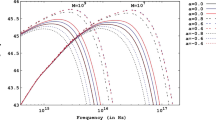Abstract
With the aid of a simple black hole model of quasars we have found that the majority of the distinguishable emission lines in the spectrum of the quasar 1604+179 can be assigned to two redshift systems,z r =3.712 andz b =2.701. The appearance of double emission redshifts means that this quasar might be a massive black hole (of mass 108 M •≤M≤1011 M •) with a ring-like emission line region (of radius 1 light-day ≤r 0≤1 light-year) in its accretion disk.
Similar content being viewed by others
References
Burbidge, E. M., Smith, H. E., Junkkarinen, V. S., and Hoag, A. A.: 1985,Astrophys. J. 288, 82.
Deng Tieru: 1985, in preparation.
Fang Lizhi and Deng Tieru: 1982,Acta Physica Sinica 1, 110.
Author information
Authors and Affiliations
Rights and permissions
About this article
Cite this article
Liu, YZ., Deng, ZG., Zhou, YY. et al. Possible evidence for a massive black hole in a quasar with double redshift systems. Astrophys Space Sci 123, 137–144 (1986). https://doi.org/10.1007/BF00649129
Received:
Issue Date:
DOI: https://doi.org/10.1007/BF00649129




